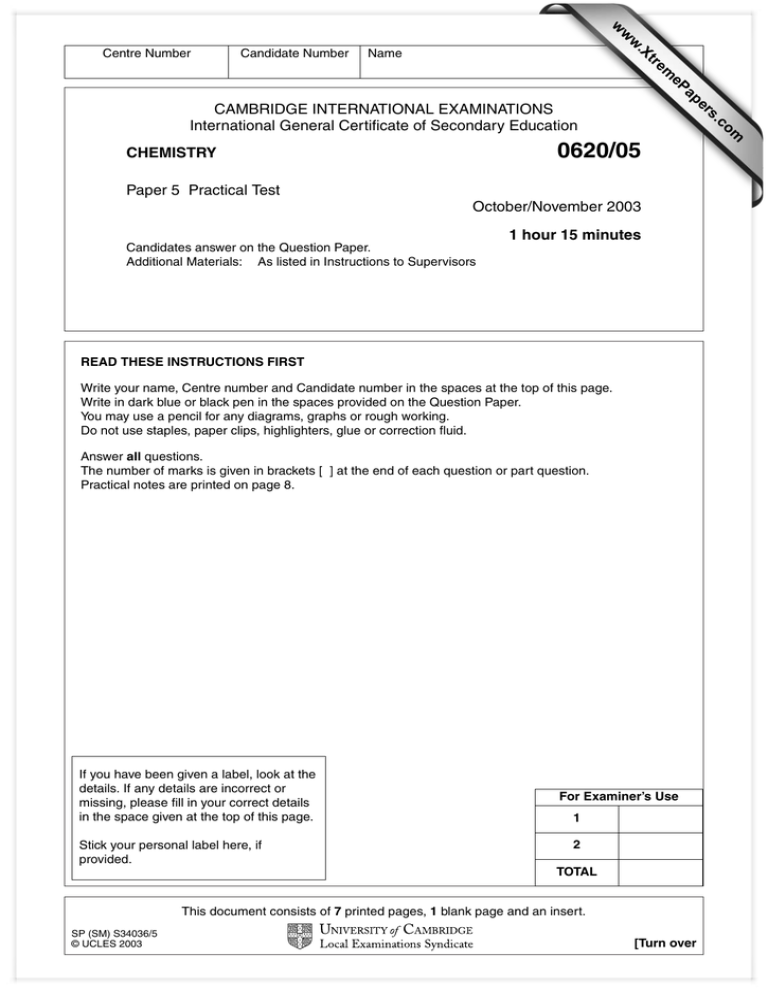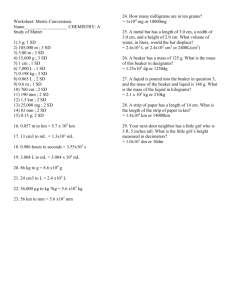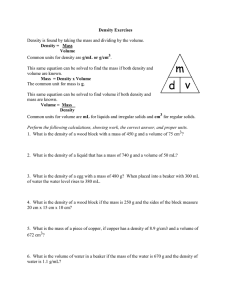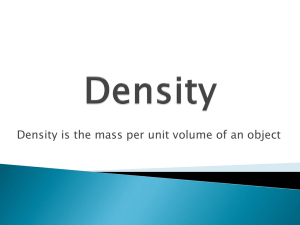0620/05
advertisement

w w Name ap eP m e tr .X Candidate Number w Centre Number 0620/05 CHEMISTRY Paper 5 Practical Test October/November 2003 1 hour 15 minutes Candidates answer on the Question Paper. Additional Materials: As listed in Instructions to Supervisors READ THESE INSTRUCTIONS FIRST Write your name, Centre number and Candidate number in the spaces at the top of this page. Write in dark blue or black pen in the spaces provided on the Question Paper. You may use a pencil for any diagrams, graphs or rough working. Do not use staples, paper clips, highlighters, glue or correction fluid. Answer all questions. The number of marks is given in brackets [ ] at the end of each question or part question. Practical notes are printed on page 8. If you have been given a label, look at the details. If any details are incorrect or missing, please fill in your correct details in the space given at the top of this page. Stick your personal label here, if provided. For Examiner’s Use 1 2 TOTAL This document consists of 7 printed pages, 1 blank page and an insert. SP (SM) S34036/5 © UCLES 2003 [Turn over om .c s er CAMBRIDGE INTERNATIONAL EXAMINATIONS International General Certificate of Secondary Education 2 1 You are going to investigate the speed of reaction between aqueous potassium bromate and potassium iodide solution. Read all the Instructions below carefully before starting the experiments. Instructions Fill the burette upto the 0.0 cm3 mark with the aqueous potassium iodide. Put 5 test-tubes in a rack. Using the burette, add 6 cm3 of aqueous potassium iodide to each test-tube to be used in the 5 following experiments. Experiment 1 You are going to measure 5 different solutions into a small beaker. Use the 10 cm3 measuring cylinder to measure all the solutions. The cylinder does not need rinsing between additions. Using the measuring cylinder pour 12 cm3 of the aqueous potassium bromate into the small beaker. Use the 10 cm3 measuring cylinder to add 2 cm3 of hydrochloric acid and 4 cm3 of water to the beaker. Now add 5 cm3 of starch solution and 1 cm3 of sodium thiosulphate solution to the beaker. Place the beaker on the insert. Add 6 cm3 of aqueous potassium iodide from a test-tube to the mixture in the beaker and start your timer. Stop the timer when you can no longer read the words on the insert when looking down through the beaker. Record the time in the table. Pour away the contents of the beaker and rinse the beaker with distilled water. table of results experiment volume time/s potassium bromate/cm3 water/cm3 1 12 4 2 10 6 3 8 8 4 6 10 5 4 12 [4] 0620/05/O/N/03 For Examiner’s Use 3 For Examiner’s Use Experiment 2 Using a measuring cylinder pour into the beaker 10 cm3 of the potassium bromate solution. Follow the instructions exactly as given for Experiment 1, using the same volumes of the other reagents, but this time add 6 cm3 of water to the beaker. Record your time in the table. Experiments 3, 4 and 5 Repeat Experiment 1 using the volumes of aqueous potassium bromate and water specified in the table of results. Record the times in the table. 0620/05/O/N/03 [Turn over 4 (a) Plot your results on the grid. Draw a smooth line graph. [4] time/s 1 2 3 Experiment number 0620/05/O/N/03 4 5 For Examiner’s Use 5 (b) Describe how the appearance of the mixture in the beaker changed as you timed the reaction. For Examiner’s Use ......................................................................................................................................[2] (c) From your graph estimate the time of the reaction if Experiment 1 was repeated using 7 cm3 of potassium bromate and 9 cm3 of water. ......................................................................................................................................[2] Show clearly on your graph how you worked out your answers. (d) (i) [1] Which Experiment is the quickest? ...............................................................................................................................[1] (ii) Explain why this Experiment is the quickest. ................................................................................................................................... ................................................................................................................................... ...............................................................................................................................[2] (e) (i) State two sources of error in the Experiments. 1 ................................................................................................................................ ................................................................................................................................... 2 ................................................................................................................................ ...............................................................................................................................[2] (ii) Suggest two improvements to reduce the sources of error in the experiments. 1 ................................................................................................................................ ................................................................................................................................... 2 ................................................................................................................................ ...............................................................................................................................[2] 0620/05/O/N/03 [Turn over 6 2 For Examiner’s Use You are provided with an aqueous solution of substance X. Carry out the following tests on X, record all of your observations in the table. Do not write any conclusions in the table. tests observations (a) colour of solution X. .....................................................................[1] (b) (i) (ii) By using a teat pipette add drops of aqueous sodium hydroxide to about 2 cm3 of the solution in a test-tube. Now add excess aqueous sodium hydroxide to the test-tube. .....................................................................[3] Carefully warm the mixture. ......................................................................... Test any gas given off with damp indicator paper. ......................................................................... ......................................................................... ......................................................................... .....................................................................[2] (c) Repeat (b)(i) using aqueous ammonia instead of aqueous sodium hydroxide. ......................................................................... ......................................................................... .....................................................................[3] (d) Acidify about 2 cm3 of solution X with dilute sulphuric acid. Add two pieces of zinc. Warm the mixture gently. Test the gas given off. ......................................................................... ......................................................................... .....................................................................[3] Leave the mixture to react for 10 minutes. After 10 minutes decant the liquid and repeat test (b)(i). .....................................................................[2] (e) Add a few drops of hydrochloric acid to about 2 cm3 of solution X in a test-tube. Add about 1 cm3 of barium chloride solution to the mixture. .....................................................................[2] (f) ......................................................................... What conclusions can you draw about substance X? .......................................................................................................................................... .......................................................................................................................................... ......................................................................................................................................[4] 0620/05/O/N/03 7 BLANK PAGE 0620/05/M/J/03 8 NOTES FOR USE IN QUALITATIVE ANALYSIS Tests for anions anion test test result carbonate (CO32–) add dilute acid effervescence, carbon dioxide produced chloride (Cl –) [in solution] acidify with dilute nitric acid, then add aqueous silver nitrate white ppt. iodide (I–) [in solution] acidify with dilute nitric acid, then aqueous lead(II) nitrate yellow ppt. nitrate (NO3–) [in solution] add aqueous sodium hydroxide then aluminium foil; warm carefully ammonia produced sulphate (SO42–) [in solution] acidify with dilute nitric acid, then aqueous barium nitrate white ppt. Tests for aqueous cations cation effect of aqueous sodium hydroxide effect of aqueous ammonia aluminium (Al 3+) white ppt., soluble in excess giving a colourless solution white ppt., insoluble in excess ammonium (NH4+) ammonia produced on warming – calcium (Ca2+) white ppt., insoluble in excess no ppt., or very slight white ppt. copper (Cu2+) light blue ppt., insoluble in excess light blue ppt., soluble in excess giving a dark blue solution iron(II) (Fe2+) green ppt., insoluble in excess green ppt., insoluble in excess iron(III) (Fe3+) red-brown ppt., insoluble in excess red-brown ppt., insoluble in excess zinc (Zn2+) white ppt., soluble in excess giving a colourless solution white ppt., soluble in excess giving a colourless solution Tests for gases gas test and test results ammonia (NH3) turns damp red litmus paper blue carbon dioxide (CO2) turns limewater milky chlorine (Cl 2) bleaches damp litmus paper hydrogen (H2) “pops” with a lighted splint oxygen (O2) relights a glowing splint 0620/05/M/J/03






